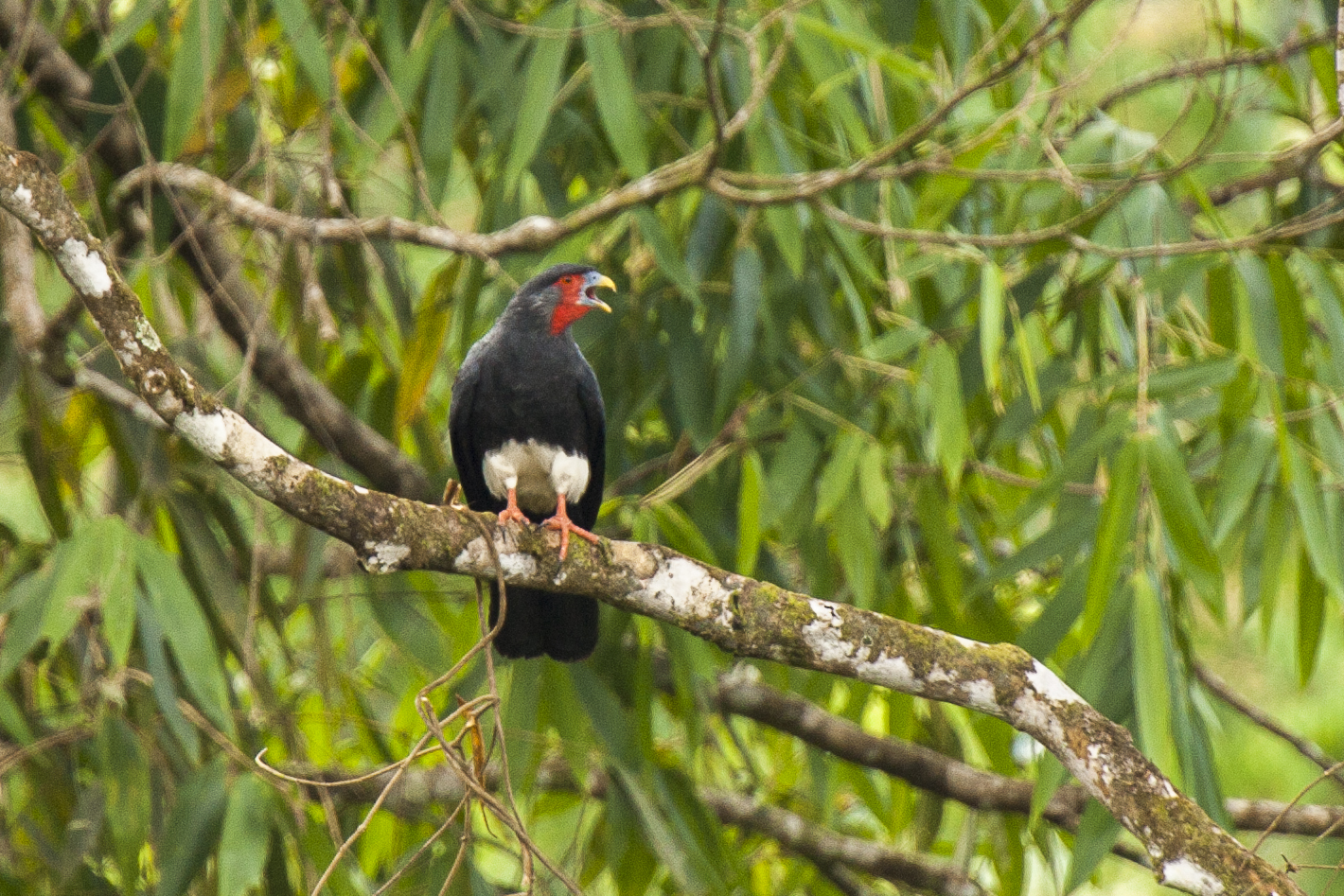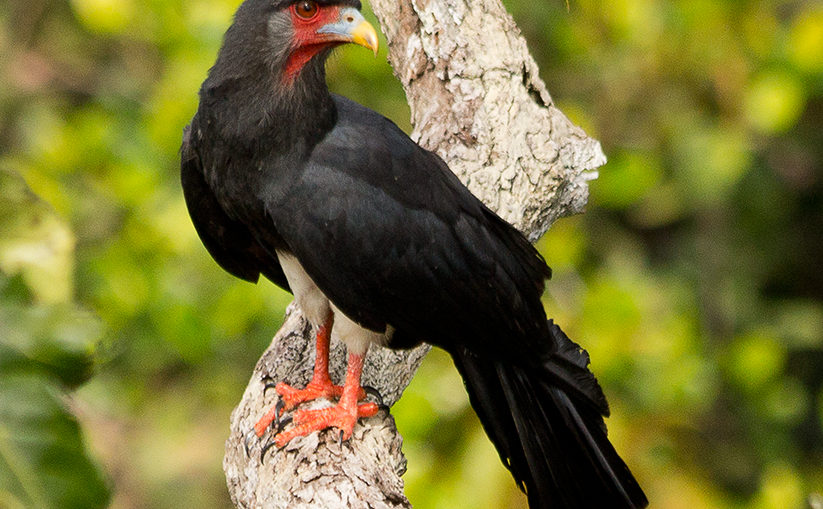“Cow-cow-cow-cacow.” When you hear that call, it usually comes from a large and raucous raptor – the red-throated caracara which can be found in Guyana. The red-throated caracara has a striking black color with a pinch of red on its throat. They are very noisy; pairs and family groups are very vocal, and their raucous calls often can be heard from great distances. The bird is a social species (bird of prey) in the family Falconidae. It is placed in the monotypic genus Ibycter, or sometimes united in Daptrius with the black caracara. It is found from Mexico south to Venezuela in most of Central and South America.
“Cow-cow-cow-cacow.” When you hear that call, it usually comes from a large and raucous raptor – the red-throated caracara which can be found in Guyana. The red-throated caracara has a striking black color with a pinch of red on its throat. They are very noisy; pairs and family groups are very vocal, and their raucous calls often can be heard from great distances. The bird is a social species (bird of prey) in the family Falconidae. It is placed in the monotypic genus Ibycter, or sometimes united in Daptrius with the black caracara. It is found from Mexico south to Venezuela in most of Central and South America.
Features Of The Red-Throated Caracara
- Colour – They are distinguished from the black caracara by larger size and plumage that is mainly black, with the belly, tail feathers, and undertail feathers being white. Both their faces and throats are bare with a few black feathers scattered on the throat; the exposed skin is red. Both male and female red-throated caracaras are similar in appearance.
- Wing Length – Males have a wing length of 35.55 cm, a tail length of 24.96 cm, a bill length of 2.5 cm, and a tarsus length of 5.41 cm. Females have a wing length of 35.93 cm, a tail length of 25.31 cm, a bill length of 2.58 cm, and a tarsus length of 5.62 cm.
- Length – Males average 20.1 in (51 cm) long, while females average 22.1 in (56 cm).

Red-Throated Caracara | By Francesco Veronesi from Italy – Red-throated Caracara – Manu NP_8602, CC BY-SA 2.0, https://commons.wikimedia.org/w/index.php?curid=39980659
Scientific Classification Of The Red-Throated Caracara
Red-Throated Caracara – Ibycter americanus [Scientific name]
- Kingdom: Animalia
- Phylum: Chordata
- Class: Aves
- Order: Falconiformes
- Family: Falconidae
- Genus: Ibycter
- Species: I. americanus
Habitat Of The Red-Throated Caracara
The red-throated caracara inhabits the humid lowland forests of Bolivia, Brazil, Colombia, Costa Rica, El Salvador, Ecuador, French Guiana, Guatemala, Guyana, Honduras, Mexico, Nicaragua, Panama, Peru, and Venezuela. The slow flight of the red-throated caracara makes it suited to fly in the understory of the forest where the vegetation is thin. The sparse vegetation gives the red-throated caracara greater visibility to spot food and predators. The ornate hawk-eagle and the black-and-white hawk-eagle are predators of the red-throated caracara.
Diet Of The Red-Throated Caracara
Their diet consists mainly of wasp and bee larvae, though it will eat mature insects and also forage on fruits and berries found in the humid subtropical and tropical lowlands, and mountainous regions of its Central and South American habitat. Biodiversity of the forest ecosystem is paramount for the birds’ special diet, since wasps and bees often make their nests in hollows or amongst branches of mature trees found in old-growth forests.
Hunting: The red-throated caracara hunts in the canopy and the understory of the lowland jungle, foraging mainly for insect nests. Most red-throated caracaras hunt silently, but occasionally make soft caws and sometimes hunt in groups. When hunting in groups, one or two individuals scout for predators in the canopy, while the remaining flock hunts in the understory. The red-throated caracara is highly territorial, with four to eight individuals in a group.
Reproduction Of The Red-Throated Caracara
The breeding season varies according to the range, the latitude, the altitude and the food resources. The red-throated caracara’s nest is made with sticks and situated in tree. It is often hidden in dense vegetation. The female lays 2 or 3 white of buff eggs with brown spots. The nesting behaviour of this species is poorly known, but these birds practice communal nest-guarding and nesting duties, that are uncommon behaviour in Falconidae. Usually, the pair-bonds last all the year in these sedentary birds.
Ten Facts About The Red-Throated Caracara
- Scientific footage shows the birds using a rapid-fire “fly-by” aerial-diving attack strategy to knock nests down onto the forest floor, while skillfully evading most wasp stings.
- The birds use air squadron precision, repeatedly diving then scooping upward, to drive off or confuse angry defender swarms around the hive.
- The red-throated caracara has a complex social structure within the group, not so common in birds of prey. There is a hierarchy in the small group. Often two birds are required as sentinels and guard the nest-site aggressively. Usually, the other members of the group feed these sentinels.
- These birds are very territorial and remain for long time (about five years) in the same territory. They are sedentary and defend it all year round. These aggressive displays are accompanied by loud calls.
- The sentinels take turns at nest. When a member of the group brings a wasp nest, one of the sentinels leaves the nest-site for feeding, while the last arrived replaces it. Four birds may be seen delivering food at nest.
- The red-throated caracara is gregarious, often seen flying in noisy flocks through the canopy. It also flies low and may be seen even on the ground.
- It perches on treetops along the forest edges or streams. When in dense forest, it perches lower or on the ground.
- The red-throated caracara feeds mainly on wasp and bee larvae and eggs. It also takes the hard palm fruits, varied invertebrates and turtle eggs.
- The bare skin of face and throat allows these birds to take the prey into the wasp’s colony. Usually, the wasps never attack the birds, and stay about one metre away from the red-throated caracaras, suggesting that these birds have a kind of repellent which protects them.
- Other birds’ species take advantage of the caracara’s group for safety and they follow the flocks during long time.
Red-Throated Caracara In Guyana
This article would have shown you that the red-throated caracara is often very noisy. It utters a strange raucous carrying call “cowh-cah-cowh” or “ah-ah-ah-aou”. We can also hear a longer series of “cow-cow-cow-cacow”. In flight, it gives a throaty “rrrah”. At some distance, these sounds may suggest several macaws. The calls are accompanied by nodding of the head and alternate wing beats. Vocalizations maintain the cohesion within the group. It is black overall, with a white belly and red throat. Mysteriously, wasps do not attack birds feeding at their vespiary. Most feeding occurs on the ground, although generally at least one or two birds in a feeding group remain in the canopy, presumably to watch for danger. Red-throated caracara is a highly-territorial cooperative breeder and groups often stay together for many years.
Article References:
- https://en.wikipedia.org/wiki/Red-throated_caracara
- https://neotropical.birds.cornell.edu/Species-Account/nb/species/retcar2/overview
- http://www.oiseaux-birds.com/card-red-throated-caracara.html
- Image https://upload.wikimedia.org/wikipedia/commons/7/7a/Red-throated_Caracara_-_Manu_NP_8602_%2815525174511%29.jpg







